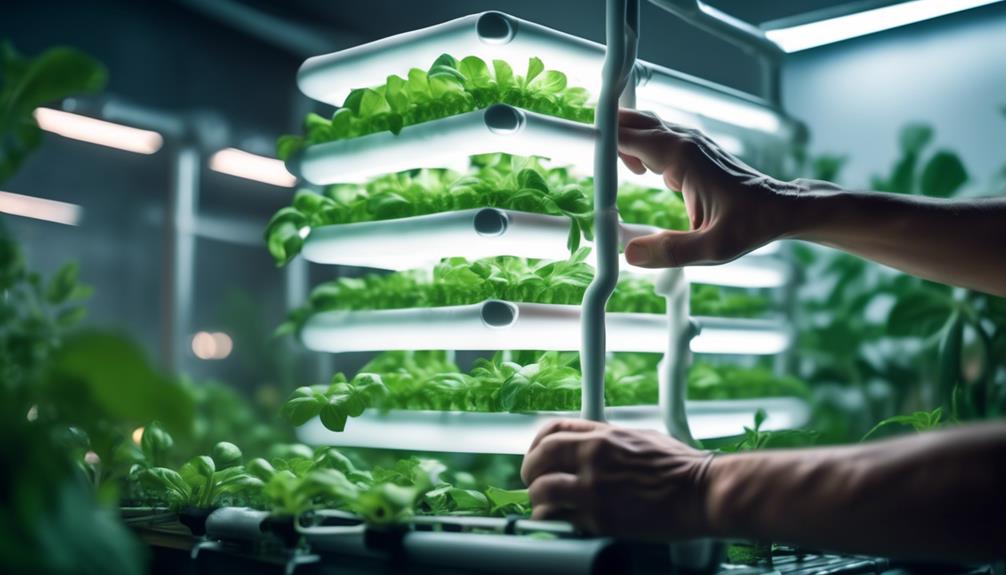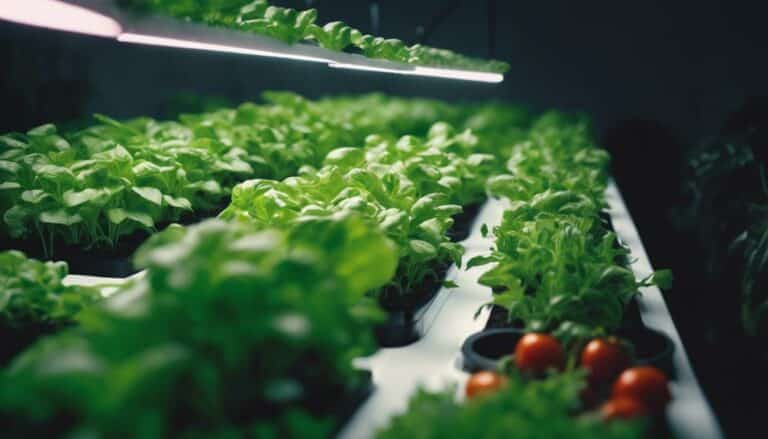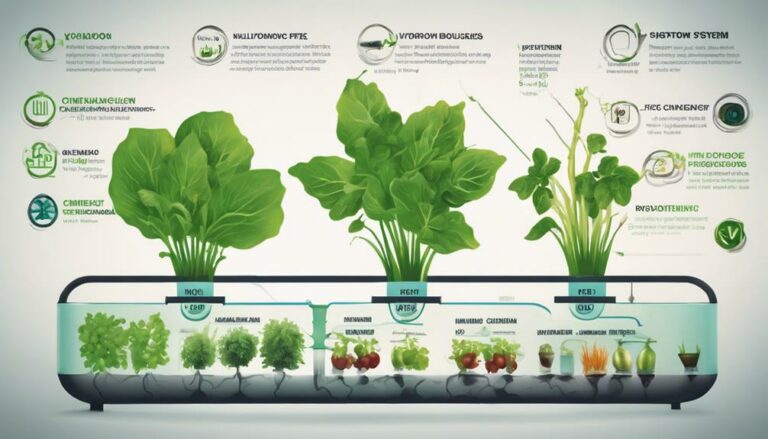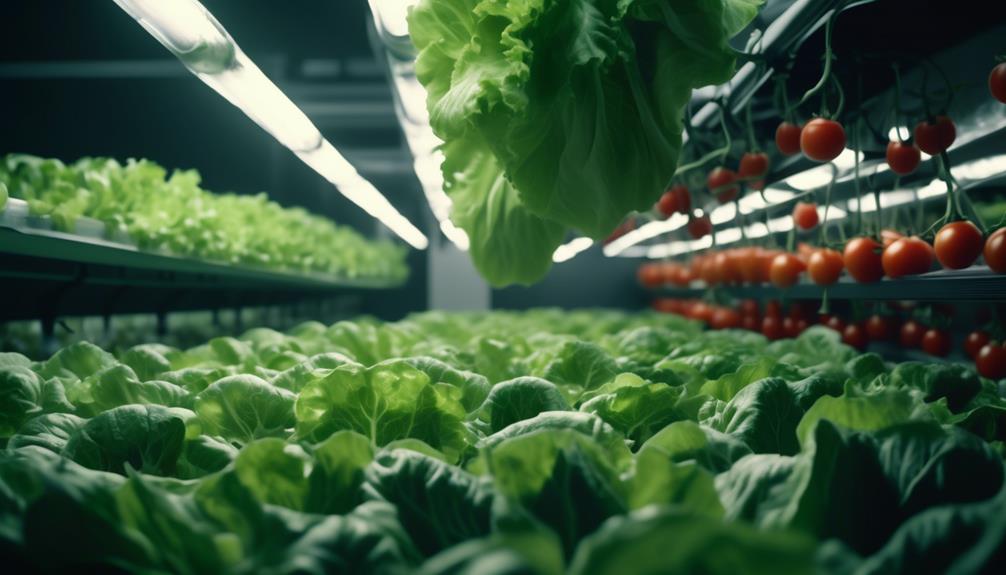As the first rays of dawn filter through our workshop windows, we’re reminded of the endless possibilities that a day can bring—especially when it comes to pioneering new ways to cultivate our food.
We’ve set out to demystify the process of building a vertical hydroponic system, a method that allows urban farmers and hobbyists alike to grow produce in a fraction of the space required by traditional soil-based gardens. Our guide is meticulously crafted with precision and the expertise that comes from years of hands-on experience in hydroponic agriculture.
Table of Contents
We’ll walk you through each step, from selecting the ideal location to the complex intricacies of nutrient delivery systems.
Yet, as we lay out the foundation for constructing your own green tower, we’re acutely aware that the journey from seed to harvest is riddled with nuanced decisions. Stay with us as we unveil how to navigate these choices effectively, ensuring your vertical garden not only thrives but also revolutionizes your approach to sustainable agriculture.
Choosing Your Location
When setting up a vertical hydroponic system, it’s crucial to pick a location that not only receives ample sunlight but also supports year-round growing, whether it’s a compact balcony or a spacious rooftop. We must consider every variable that can impact the success of our plants. Selecting a sunny spot is just the beginning; we also need to ensure our chosen site provides access to both water and electricity, which are essential for the system’s operation.
We have to think about the practical aspects of maintenance. That means choosing a location that’s easily accessible for regular monitoring and any necessary adjustments. Monitoring the water level and ensuring the submersible pump is functioning correctly are tasks we’ll perform frequently. An overlooked yet critical factor is the weight and structural integrity of our location. Our vertical hydroponic system will be heavy, especially when water is added, so it’s imperative that the structure can support the weight without any risk of damage.
Innovation in our gardening approach demands thorough planning. By meticulously selecting our location, we’re setting the stage for a flourishing vertical hydroponic garden that maximizes space and yields.
Gathering Materials
Before we begin constructing our vertical hydroponic system, we’ll need to gather a specific list of essential components. We’ll source quality supplies such as a durable 45-gallon tank and a reliable submersible pump, ensuring our system’s longevity and effectiveness.
Additionally, we’ll assemble the necessary tools for the build, which include precision cutting and drilling equipment for perfecting our tower structure.
Essential Components List
To successfully build a vertical hydroponic system, you’ll need to gather a variety of essential components. Here’s a concise list of the materials you’ll require:
- Structure: A white vinyl fence post for the main tower, pyramid post tops to protect and finish the top, and end caps to seal the bottom.
- Reservoir: A 45-gallon tank to hold the nutrient solution, ensuring your plants receive consistent nourishment.
- Circulation: A submersible pump to move the nutrient solution, along with 3-inch PVC pipes for distribution.
- Support: 5/8-inch x 5/8-inch x 8-foot white vinyl blind stop molding to create net pot holders for high density plant support.
This method of growing plants maximizes space and resources.
Sourcing Quality Supplies
Having listed the essential components for our vertical hydroponic system, we now focus on the importance of sourcing high-quality supplies to ensure durability and efficiency in our setup.
It’s crucial to select a sturdy white vinyl fence post and a robust 45-gallon tank that can withstand the rigors of constant water flow.
For the tower construction, we must find 3-inch PVC pipe that’s easy to cut, allowing us to prepare pot holes accurately. Net pot holders must be compatible and secure for plant support.
We also opt for standard Schedule 40 PVC or equivalent materials for the frame, offering reliable strength.
Make sure to choose a powerful submersible pump to maintain optimal water circulation.
Tools for Assembly
Assembling a vertical hydroponic system requires a precise selection of tools, ensuring seamless construction and functionality. To guarantee our success, we’ve honed in on the essentials, focusing on tool selection that compliments our innovative design. Here’s what we’ll need:
- Drill and Drill Bits: For making precise holes in the vinyl fence post and PVC pipe.
- PVC Cutter or Saw: To cleanly cut the 3-inch PVC pipe to the desired lengths.
- Measuring Tape: Essential for accurate measurements, ensuring the system components fit perfectly.
- Wrench and Pliers: For assembling the submersible pump and securing connections.
We’ve mastered tool assembly techniques and understand the importance of tool maintenance, which will keep our system running efficiently for years to come.
Assembling the Frame
Let’s begin by cutting the fence post to the precise height required for our vertical hydroponic tower, ensuring a solid foundation for the frame assembly. Frame stability is crucial, so we’ll ensure the height we choose not only accommodates the plant growth but also maintains the structural integrity. We’re considering height considerations to optimize sunlight exposure and ease of maintenance.
Once our post is cut, we’ll prepare the net pot supports using 3-inch PVC pipe. To ensure proper water exit, a rectangular cut is made at the tower’s base. We’ll methodically attach net pot holders along the tower’s length, providing secure spots for our plants. Lastly, we drill holes atop one post to allow for nutrient solution distribution.
To engage our audience further, here’s a table outlining the steps:
| Step | Material | Description |
|---|---|---|
| 1 | Fence post | Cut to desired height |
| 2 | PVC pipe | Prepare net pot supports |
| 3 | Tower base | Make water exit cut |
| 4 | Tower length | Attach net pot holders |
| 5 | Post top | Drill for nutrient distribution |
We’re also exploring weatherproofing options to protect our system from the elements. This innovation in hydroponics promises an efficient, high-yield future for urban farming.
Installing Grow Towers
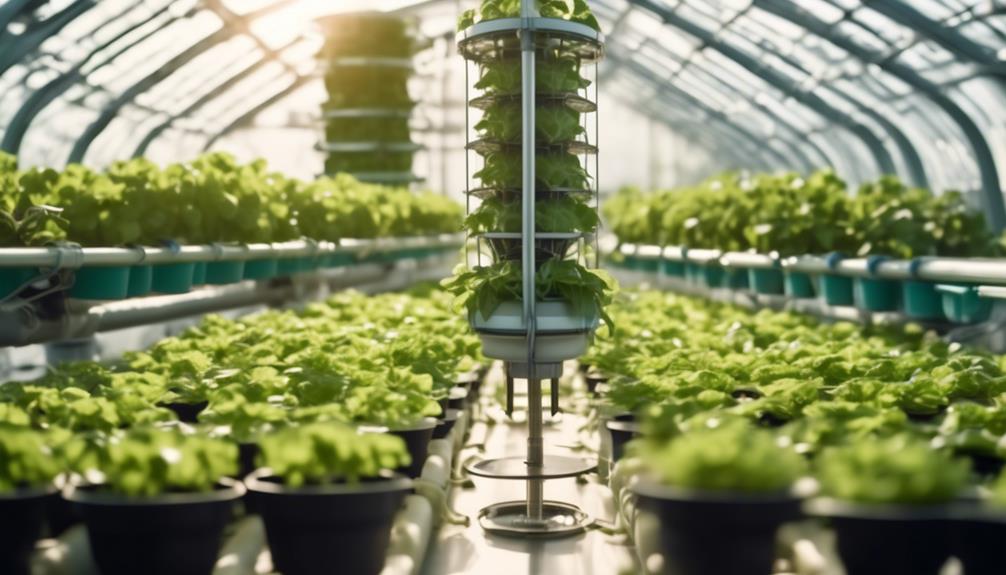
We’ve assembled the frame; now it’s time to focus on installing grow towers in our vertical hydroponic system.
Selecting the right towers is crucial—they must suit our plants’ needs and fit seamlessly within the frame we’ve built.
We’ll walk you through how to assemble these towers correctly and strategize their placement for optimal plant growth and system efficiency.
Selecting Suitable Grow Towers
When selecting grow towers for a vertical hydroponic system, it’s crucial to consider the available space and anticipated plant count to ensure proper fit and function. We’re focused on:
- Maximizing space utilization by evaluating the tower’s footprint and vertical growth potential.
- Comparing different grow tower designs to identify the most efficient for our plant varieties and growth cycles.
- Ensuring durability of grow tower materials, seeking out high-quality, non-corrosive components that withstand nutrient solutions and moisture.
- Prioritizing towers that facilitate easy installation and maintenance, which includes pre-drilled holes and accessible water systems.
Assembling Towers Correctly
Assembling grow towers correctly is a critical step in establishing an efficient vertical hydroponic system, requiring careful attention to detail and precise construction techniques. We start by cutting white vinyl fence posts to the proper tower height, ensuring our towers will accommodate the plants’ growth. Utilizing advanced drilling techniques, we make a rectangular cut at the tower’s bottom for water exit and carefully drill holes for attaching net pot holders throughout the tower’s length.
We prepare net pot supports from 3-inch PVC pipes, which are crucial for the stability and accessibility of our plants. The top of each tower is then outfitted with white vinyl pyramid post tops—one drilled for nutrient solution distribution. We attach these tops with hinges, allowing for easy maintenance and monitoring of our innovative vertical hydroponic system.
Tower Placement Strategies
Having established the structural integrity of our towers, it’s crucial to focus on their strategic placement within the vertical hydroponic system to optimize plant growth and system efficiency.
Here’s how we’ll implement tower placement strategies:
- Maximize space by arranging towers in a pattern that allows for both dense planting and accessible pathways, ensuring efficient use of the growing area.
- Position towers to take full advantage of natural sunlight exposure, adjusting angles as necessary to promote even light distribution.
- Optimize airflow around each tower to prevent disease and promote robust plant health, avoiding overcrowding that can impede circulation.
- Place towers to facilitate easy monitoring and adjustments, ensuring water levels and nutrient solutions are within optimal ranges for plant sustenance.
Setting Up the Water System
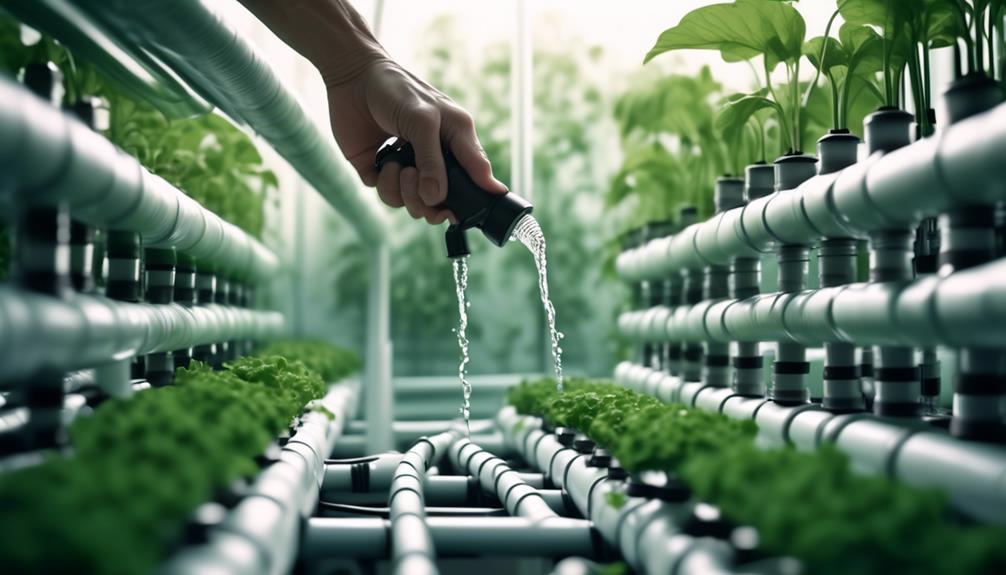
To ensure a consistent and clean water supply for our vertical hydroponic system, we’ll start by selecting a 45-gallon tank as our reservoir. This size is optimal for balancing the water volume with space efficiency. For water circulation, we’ll install a submersible pump capable of moving 400 gallons per hour, ensuring that our nutrient solution is evenly distributed throughout the system.
The importance of a well-functioning water system cannot be understated. It’s the heart of our hydroponic setup, and meticulous tank maintenance is crucial to prevent issues that could compromise plant health.
| Component | Purpose | Emotional Impact |
|---|---|---|
| 45-gallon Tank | Reservoir for nutrient solution | Provides peace of mind |
| Submersible Pump | Ensures robust water circulation | Instills confidence in system reliability |
| Plastic Lid | Protects water from contaminants | Secures the integrity of our plants |
We’ll also utilize a plastic sheet to create a lid for the tank, keeping out debris and minimizing evaporation. Coupled with a light timer for precise control over nutrient solution distribution, we’re setting up a system that not only sustains growth but also pushes the boundaries of agricultural innovation. As we move forward, we’ll ensure that the post tops are properly attached to the tower, facilitating efficient nutrient delivery to every plant.
Adding Plants and Nutrients
Selecting the right plants is essential when populating our vertical hydroponic system, ensuring compatibility and optimal growth within this innovative agricultural environment. We must consider a variety of factors that will affect the success of our system:
- Plant selection: We choose species that thrive in vertical hydroponic settings, such as leafy greens and herbs. These plants tend to have less demanding root systems and adapt well to the vertical format.
- Nutrient requirements: Our next step is to carefully mix a nutrient solution with the water. This solution provides essential elements needed for plant growth, tailored to the specific needs of our chosen crops.
- Growth monitoring: Regular observation of plant health allows us to adjust the nutrient mix and system settings. We’re vigilant for signs of nutrient deficiencies or excesses, which manifest in the foliage and growth patterns.
- System maintenance: We ensure the system delivers water, nutrients, and light consistently. Proper spacing and arrangement of plants are key to maximizing our vertical space and promoting efficient growth.
System Maintenance and Care
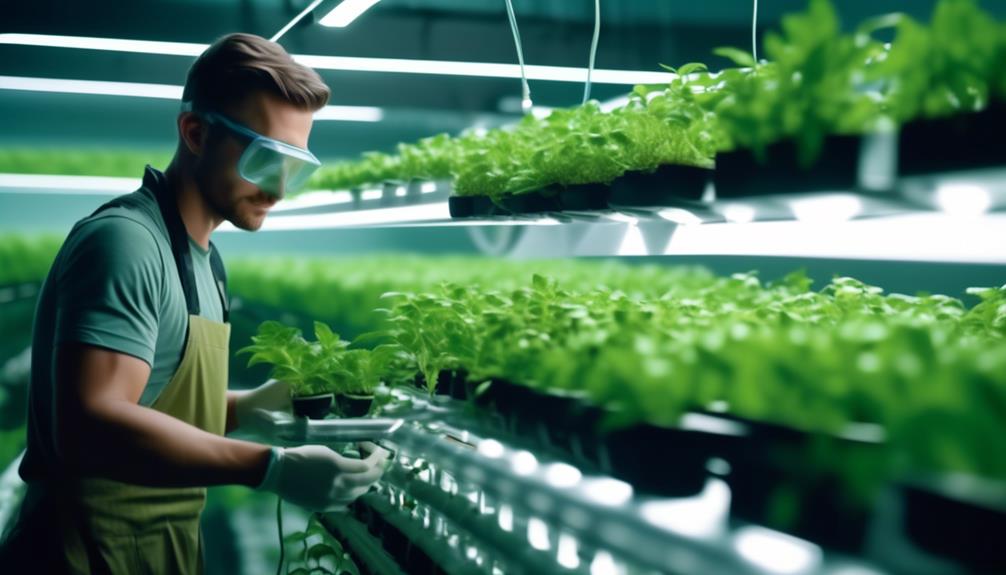
In maintaining a thriving vertical hydroponic system, we diligently monitor water levels and ensure the entire setup remains clean and well-maintained for peak plant performance. We’ve established a routine that includes advanced cleaning techniques, troubleshooting common issues, and preventing pest infestations to preserve the integrity and productivity of our system.
Our approach adapts innovative measures to tackle potential problems head-on. For instance, we manage algae growth not just through regular system cleanings but also by creatively painting or covering our buckets to block out light. This proactive step is part of our broader strategy to maintain an environment that discourages pest and disease proliferation.
Here’s a quick reference table we use:
| Maintenance Task | Frequency | Tips |
|---|---|---|
| Water Level Check | Daily | Adjust to ensure roots are adequately moist |
| System Cleaning | Bi-weekly | Disassemble and clean parts thoroughly |
| Pest Monitoring | Weekly | Inspect for signs and apply preventive measures |
Frequently Asked Questions
How Do You Grow Hydroponically Step by Step?
We’ve learned that hydroponic farms can use 90% less water. First, we select appropriate growth mediums, then add nutrient solutions, and finally, optimize lighting considerations to ensure our plants thrive hydroponically.
What Is the Easiest Hydroponic System for Beginners?
We believe the easiest hydroponic system for beginners is the vertical design due to its scalability, efficient nutrient solution distribution, and considerable hydroponic advantages, especially in optimizing space and water conservation.
How Do You Start a Vertical Farm at Home?
We’re starting our vertical farm at home by focusing on space optimization, investing in efficient lighting solutions, and implementing proactive pest management to ensure our high-density garden thrives in our urban space.
How Often Should I Water My Vertical Hydroponic Garden?
We’re nurturing our green haven by adjusting the watering frequency of our vertical hydroponic garden every 1-2 days, diligently balancing nutrient solutions, and meticulously system monitoring to maintain our plants’ vibrant growth.

